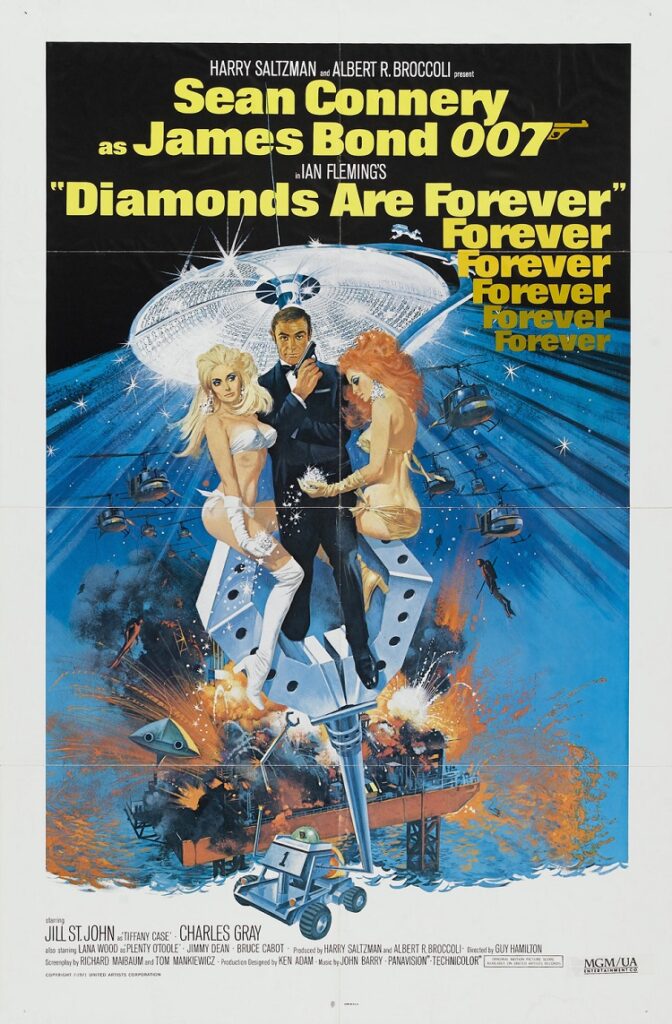
Written by Brandie Ashe
“So James Bond just walked up to a woman, whipped off her bikini top, wrapped it around her neck, and choked her with it while interrogating her.”
No less than two minutes into watching Diamonds Are Forever (1971) for the first time, I had to pause the movie to send this text to a friend of mine. And in a way, the disbelief that prompted this message sums up my reaction to the entire film. Admittedly, my experience with the James Bond canon is limited to a handful of Sean Connery starrers, a single Roger Moore title, the Pierce Brosnan versions, and the recent Daniel Craig reboots. But none of those previously viewed Bond films prepared me for the frenetic camp that is Diamonds.
Diamonds Are Forever is the seventh film in the Bond franchise, and marks Sean Connery’s return to the lead role after George Lazenby, who took over the part in 1969’s On Her Majesty’s Secret Service, decided to forego his seven-film Bond contract on the advice of his agent (while also expressing dissatisfaction for his perceived treatment by the producers on-set). Before Connery’s return was secured, the role of Bond was offered to Mexican-American actor John Gavin (arguably best known for his supporting role in Alfred Hitchcock’s 1960 film Psycho). But Gavin was dismissed (and paid off) after Connery agreed to play Bond again upon requesting–and receiving–a record-breaking salary for the role, and Connery’s Goldfinger (1964) director, Guy Hamilton, was brought back in an attempt to recapture some of that previous film’s magic. Sadly, however, lightning did not strike twice in the case of Diamonds.
This time around, Bond (Connery) immediately gets to business in the pre-credits scenes, ruthlessly tossing bodies around while hunting down Ernst Stavro Blofeld (Charles Gray), head of the terrorist organization SPECTRE. Bond discovers that Blofeld has tasked a laboratory with creating duplicates of the villain through plastic surgery. Bond kills a duplicate before encountering the “real” Blofeld, whom he kills by dousing him in some bubbling muddy gunk with a creepy, gleeful smirk.
But this somewhat promising (though admittedly outlandish) beginning is all for naught, for the subsequent film is a raging disappointment. After the not-so-subtle opening credits (Pussy cats! Diamond panties! Shirley Bassey singing “touch it, stroke it, and undress it!”), the main plot then dissolves into a mishmash of diamond smuggling; more murders; transcontinental travel; crazed, hand-holding assassins; moon buggies; ineffectual villains rising from the “dead”; laser satellites; and–last but certainly not least–sausage king/entertainer Jimmy Dean as a half-baked, country-fried mogul. Diamonds Are Forever is essentially the scatterbrained, redheaded stepchild of the Connery Bond films–indeed, it could be argued that it is the worst of the Bond films, period (though by reputation alone, there are a couple of Roger Moore flicks that might rank below it).
And, of course, there are the obligatory Bond Girls, neither of whom are even remotely memorable (let’s just say this pair of ladies would likely never make anyone’s top ten Bond Girl list). One–the first American Bond Girl–is played by a hysterical and impressively wooden Jill St. John, in a performance that I can only guess was an inspiration for Kate Capshaw’s equally shrill “heroine” in Indiana Jones and the Temple of Doom more than a decade later. The other Bond Girl, played by Lana Wood (kid sister of actress Natalie) is mere eye candy–her only job is to speak in an excessively bright tone, over-emote, and flash her ample cleavage across the screen while answering to the obligatorily suggestive name of Plenty O’Toole, all before being unceremoniously killed off-screen later in the film.
Diamonds Are Forever is a film I would recommend only to the most hardcore of James Bond fans. Connery does not seem as invested in the role as he was in earlier films; granted, I’m mainly measuring his performance against the utterly fantastic Goldfinger–my hands-down favorite Bond film–but still, the actor appears almost bored in some scenes. The plot is meandering and ill-structured, and the stunts are not nearly as breathtaking as in other films in the franchise (though I will admit the Vegas car chase, in which Bond effortlessly flings a souped-up Mustang around the city streets, is a pretty thrilling ride, no pun intended). Diamonds may be forever, but in the end, this one’s all flash and little substance.
Operation: BOND will return with Live and Let Die.